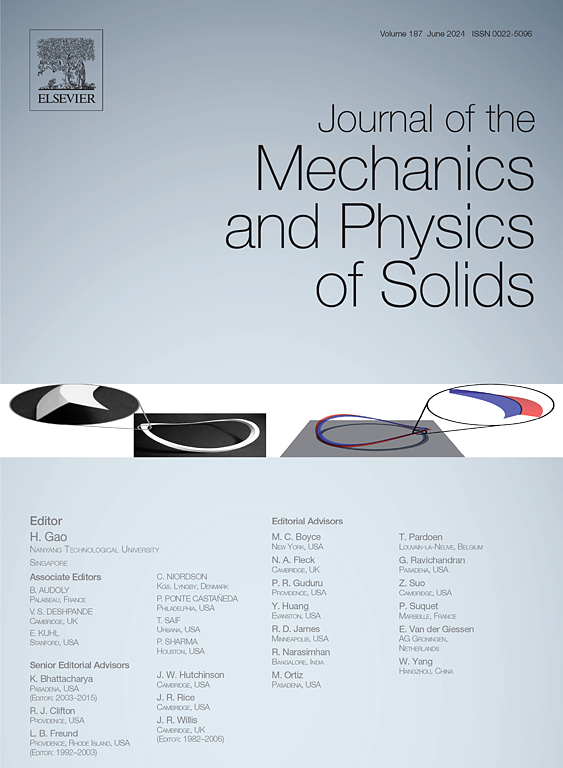A rigorously convergent and irreversible gradient damage model
IF 5
2区 工程技术
Q2 MATERIALS SCIENCE, MULTIDISCIPLINARY
引用次数: 0
Abstract
Conventional gradient damage models do not fully satisfy the convergence and monotonicity requirements of damage profiles, leading to spurious damage growth and artificially enforced irreversibility. Existing strategies that achieve convergence through empirical evolution of nonlocal interactions remain largely phenomenological, while irreversibility is typically ensured only in models tailored to strongly brittle materials. We address these fundamental issues through two key innovations. Firstly, an explicit solution for the final damage bandwidth is derived, which identifies the unbounded nonlocal variable as the cause of spurious damage growth in conventional models. To remedy this, an energy dissipation function, which vanishes the driving force with the increasing nonlocal variable, is proposed herein. This constrains the nonlocal variable to a finite interval一个严格收敛的不可逆梯度损伤模型
传统的梯度损伤模型不能完全满足损伤曲线的收敛性和单调性要求,导致了损伤的虚假增长和人为的不可逆性。通过非局部相互作用的经验进化实现收敛的现有策略在很大程度上仍然是现象学的,而不可逆性通常只在针对强脆性材料的模型中得到保证。我们通过两个关键创新来解决这些基本问题。首先,导出了最终损伤带宽的显式解,识别了常规模型中无界的非局部变量是导致虚假损伤增长的原因;为了解决这一问题,本文提出了一个能量耗散函数,该函数随非局部变量的增加而使驱动力消失。这将非局部变量限制在有限区间[1,m],从而保证了损伤曲线的收敛性。其次,通过引入附加的耗散项,建立了损伤分布与软化行为解耦的一般框架。这允许损伤进化和软化行为的精确定义分开,防止病理性损伤愈合现象。在此基础上,通过求解第一类Volterra积分方程,可以在保持损伤不可逆性的前提下,将任意内聚规律纳入所提出的模型。通过不同牵引-分离规律的数值算例验证了该模型的双重Γ-convergence和参数不敏感的力学响应。该方法为用梯度损伤模型联合描述任意准脆性材料的收敛性和单调性损伤演化过程提供了一个通用而灵活的框架。
本文章由计算机程序翻译,如有差异,请以英文原文为准。
求助全文
约1分钟内获得全文
求助全文
来源期刊
CiteScore
9.80
自引率
9.40%
发文量
276
审稿时长
52 days
期刊介绍:
The aim of Journal of The Mechanics and Physics of Solids is to publish research of the highest quality and of lasting significance on the mechanics of solids. The scope is broad, from fundamental concepts in mechanics to the analysis of novel phenomena and applications. Solids are interpreted broadly to include both hard and soft materials as well as natural and synthetic structures. The approach can be theoretical, experimental or computational.This research activity sits within engineering science and the allied areas of applied mathematics, materials science, bio-mechanics, applied physics, and geophysics.
The Journal was founded in 1952 by Rodney Hill, who was its Editor-in-Chief until 1968. The topics of interest to the Journal evolve with developments in the subject but its basic ethos remains the same: to publish research of the highest quality relating to the mechanics of solids. Thus, emphasis is placed on the development of fundamental concepts of mechanics and novel applications of these concepts based on theoretical, experimental or computational approaches, drawing upon the various branches of engineering science and the allied areas within applied mathematics, materials science, structural engineering, applied physics, and geophysics.
The main purpose of the Journal is to foster scientific understanding of the processes of deformation and mechanical failure of all solid materials, both technological and natural, and the connections between these processes and their underlying physical mechanisms. In this sense, the content of the Journal should reflect the current state of the discipline in analysis, experimental observation, and numerical simulation. In the interest of achieving this goal, authors are encouraged to consider the significance of their contributions for the field of mechanics and the implications of their results, in addition to describing the details of their work.

 求助内容:
求助内容: 应助结果提醒方式:
应助结果提醒方式:


